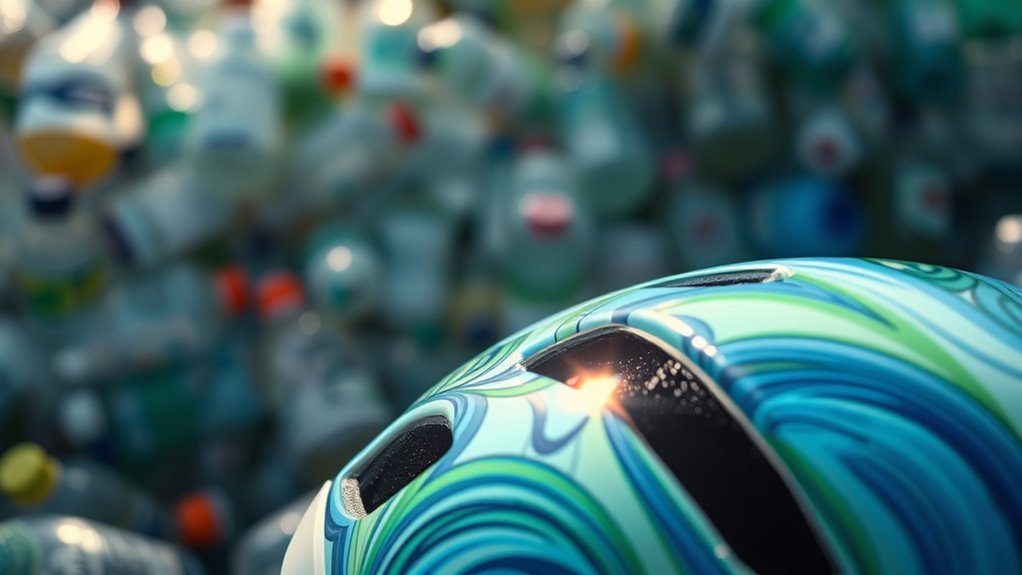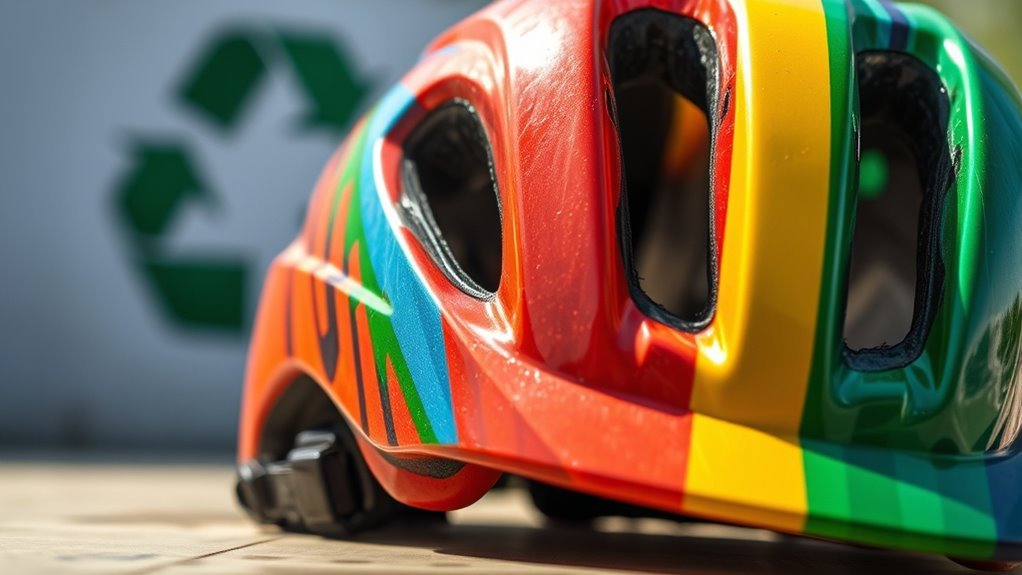Recycled Plastic in Helmets: Pros and Cons
Recycled plastic in helmets offers notable environmental advantages, like reducing waste and lowering carbon footprints. However, there are concerns regarding safety, as recycled materials may not consistently meet required strength and impact resistance standards. Cost implications arise from sourcing and processing recycled materials, which can affect pricing. Consumer acceptance hinges on perceptions of durability and performance. Exploring these factors further reveals how they impact manufacturing trends and market dynamics in helmet production.
Understanding Recycled Plastic

As you immerse yourself in the world of recycled plastic, it’s important to understand its composition and properties. Recycled plastic primarily comes from various recycled sources, including post-consumer waste and industrial scrap. Each plastic type, such as PET, HDPE, and PVC, possesses distinct characteristics affecting its suitability for applications like helmet production. For instance, PET is known for its strength and flexibility, while HDPE offers excellent impact resistance. Understanding these properties enables you to evaluate the performance and durability of recycled plastics in helmets. By recognizing the differences in plastic types, you can make informed decisions regarding material selection, ensuring that the helmets not only meet safety standards but also contribute to a more sustainable future.
Environmental Benefits of Recycled Plastic in Helmet Production

Using recycled plastic in helmet production greatly reduces plastic waste by repurposing materials that would otherwise contribute to landfills. This practice not only helps in managing waste but also results in a lower carbon footprint during the manufacturing process. By choosing helmets made from recycled materials, you’re supporting a more sustainable approach to consumer products.
Reduced Plastic Waste
While the production of helmets traditionally relies on virgin materials, integrating recycled plastic markedly reduces plastic waste and mitigates environmental impact. This approach not only promotes waste reduction but also encourages the advancement of recycling processes. By utilizing materials that would otherwise contribute to landfills, you’re supporting a circular economy that values resource efficiency. The incorporation of recycled plastics in helmets demonstrates a commitment to sustainability and responsible consumption. In addition, reducing reliance on new plastic production decreases the overall demand for fossil fuels, further enhancing environmental benefits. As consumers, by choosing helmets made from recycled materials, you’re actively participating in a broader movement toward reducing plastic waste and fostering a healthier planet for future generations.
Lower Carbon Footprint
The incorporation of recycled plastic in helmet production greatly contributes to a lower carbon footprint. By utilizing recycled materials, manufacturers can considerably reduce the energy consumption typically associated with producing new plastics. This not only decreases greenhouse gas emissions but also aligns with carbon offsetting strategies aimed at mitigating climate change. Sustainable production practices in this situation further enhance efficiency, as they often involve streamlined processes that minimize waste. As you consider your helmet options, remember that choosing products made from recycled plastics supports a circular economy, promoting resource conservation and environmental stewardship. Ultimately, this decision empowers you to contribute to a more sustainable future while maintaining safety and performance standards in helmet design.
Safety Standards and Regulations

As manufacturers increasingly incorporate recycled plastics into helmet production, understanding the relevant safety standards and regulations becomes fundamental. Helmets must meet specific safety certifications, such as those established by the Consumer Product Safety Commission (CPSC) and the European Committee for Standardization (CEN). These standards guarantee that any helmet, regardless of materials, offers adequate protection in the event of an impact. Regulatory compliance is essential for manufacturers, as failure to adhere to these guidelines can result in penalties, recalls, or reputational damage. It’s important for you, as a consumer, to verify that any recycled plastic helmet you consider meets these certifications, confirming that you prioritize safety alongside sustainability in your purchase decisions.
Durability and Performance Comparison
When evaluating helmets made from recycled plastic, it’s essential to conduct a material strength analysis to determine their structural integrity. You’ll also want to look at impact resistance testing results, as these indicate how well the helmet can absorb shock during an accident. Finally, evaluating longevity and wearability will provide insight into how these helmets perform over time compared to traditional materials.
Material Strength Analysis
While traditional helmet materials like polycarbonate and fiberglass have long been trusted for their durability and performance, recycled plastic offers a compelling alternative that warrants a thorough analysis. This material’s composition can impact its overall strength and usability in helmet manufacturing. Here’s a comparative strength evaluation of both materials:
| Material | Strength (MPa) |
|---|---|
| Polycarbonate | 70 |
| Fiberglass | 150 |
| Recycled Plastic | 50-100 |
Understanding the range of recycled plastic’s strength helps you gauge its performance potential. Although it may not match fiberglass, advancements in processing techniques are continuously improving its properties. Consequently, considering recycled plastic could align with your values of sustainability while still providing adequate protection.
Impact Resistance Testing
Although traditional materials have established benchmarks for impact resistance, the performance of recycled plastic helmets under similar conditions is essential for evaluating their viability. To assess their durability, specific testing methods are employed that measure how well these helmets absorb and distribute impact forces. Here are four key aspects evaluated during impact resistance testing:
- Drop Tests: Helmets are subjected to controlled falls from designated heights.
- Penetration Tests: Sharp objects are used to test the helmet’s ability to withstand punctures.
- Dynamic Impact Testing: Simulated collisions assess real-world performance.
- Temperature Variation Tests: Helmets are exposed to extreme temperatures to evaluate changes in performance.
Understanding these factors helps gauge whether recycled plastic can match or exceed traditional materials in safety standards.
Longevity and Wearability
As the demand for sustainable materials grows, evaluating the longevity and wearability of recycled plastic helmets becomes essential in understanding their practicality. Longevity factors such as material composition and environmental resistance play a significant role in determining how long these helmets can perform effectively. While recycled plastics can offer adequate durability, they may face wearability concerns like comfort and fit. Over time, recycled materials might degrade differently than traditional plastics, affecting their structural integrity. It’s vital to take into account how factors like UV exposure and moisture can impact both the lifespan and comfort of the helmet. Ultimately, balancing durability with user experience will dictate the acceptance and effectiveness of recycled plastic helmets in the market.
Cost Implications of Using Recycled Materials
When considering the integration of recycled materials into helmet production, it is vital to analyze the cost implications that arise. You’ll find that while recycled plastics can enhance cost efficiency, there are still several factors to evaluate:
- Raw Material Costs: Sourcing recycled plastics can be cheaper, but quality variations may impact overall production expenses.
- Manufacturing Adjustments: Adapting machinery for recycled materials might entail additional costs.
- Price Comparison: Comparing the final price with traditional helmets is essential to gauge market competitiveness.
- Market Demand: As consumer interest in sustainable products grows, pricing strategies may shift, potentially affecting profit margins.
Understanding these factors helps you make informed decisions about the economic viability of using recycled materials in helmet production.
Consumer Perception and Acceptance
While many consumers are increasingly aware of environmental issues, their perception of helmets made from recycled plastics can vary greatly. Consumer attitudes toward these products often hinge on factors such as safety, quality, and sustainability. Some consumers embrace the eco-friendly aspect, aligning their purchasing decisions with market trends that prioritize environmental responsibility. Others, however, may question the durability or protection levels of recycled materials, impacting their acceptance. As manufacturers continue to promote the benefits of recycled plastics, understanding these varying attitudes becomes essential. To successfully penetrate the market, companies must address concerns about performance while emphasizing the positive environmental impact, thereby fostering a more favorable consumer perception and encouraging broader acceptance of recycled plastic helmets.
Innovations and Future Trends in Helmet Manufacturing
Innovations in helmet manufacturing are reshaping safety standards and consumer expectations, particularly with the integration of advanced materials and smart technology. You’ll find that these trends emphasize both functionality and sustainability, aligning with the growing demand for responsible choices. Here are some key innovations to watch for:
- Smart Manufacturing: Automation and data analytics streamline production, enhancing efficiency and consistency.
- Integrated Sensors: Helmets equipped with impact detection and health monitoring systems improve user safety.
- Sustainable Design: Utilizing recycled materials reduces environmental impact, appealing to eco-conscious consumers.
- Customization: Advances in 3D printing enable tailored designs, allowing for a perfect fit and personalized aesthetics.
These advancements not only elevate safety but also redefine consumer engagement in helmet design.
Frequently Asked Questions
How Is Recycled Plastic Sourced for Helmet Production?
Recycled plastic for helmet production is sourced primarily through various collection and processing methods. You’ll find it comes from post-consumer waste, like bottles and containers, which are collected, sorted, and cleaned. The environmental impact of these sourcing methods is significant, as they reduce landfill waste and lower the demand for virgin materials. By utilizing recycled sources, you’re contributing to a more sustainable cycle, promoting eco-friendliness while ensuring the quality of the helmets produced.
Are There Specific Brands Known for Using Recycled Plastic?
Yes, brands like Trek and Bell are known for incorporating recycled plastic into their helmets, reflecting a growing trend in sustainability initiatives. Notably, studies show that using recycled materials can reduce carbon emissions by up to 60%. When making brand comparisons, consider how each company balances performance with eco-friendliness. You’ll find that some brands prioritize sustainability more than others, making it essential to evaluate their commitments to environmental responsibility.
Can Recycled Plastic Helmets Be Recycled Again?
Yes, recycled plastic helmets can be recycled again, but there are durability concerns. The recycling process for these helmets involves breaking down the materials, which may reduce structural integrity. As a result, while the potential exists for multiple recycling iterations, the performance of the final product may be compromised. It’s crucial to assess the balance between sustainability and the functional quality of helmets when evaluating their recyclability.
What Types of Recycled Plastics Are Commonly Used?
Commonly used recycled plastics include PET (polyethylene terephthalate) and HDPE (high-density polyethylene). These materials not only help reduce environmental impact but also offer impressive durability for helmets. PET, often sourced from recycled bottles, provides lightweight strength, while HDPE is known for its resistance to impact and weathering. By choosing these materials, you’re contributing to a sustainable cycle, ensuring that the helmets you wear maintain both safety and performance without compromising the planet’s health.
How Does Weather Affect Recycled Plastic Helmets?
Weather can greatly impact recycled plastic helmets. Studies show that UV degradation can reduce the structural integrity of certain plastics by up to 30% over time. This means that in regions with intense sunlight, helmets may become brittle and less effective. Additionally, temperature resistance varies among recycled materials, with some losing form or flexibility in extreme heat or cold. Consequently, understanding these effects is essential for ensuring safety and performance in varying conditions.






